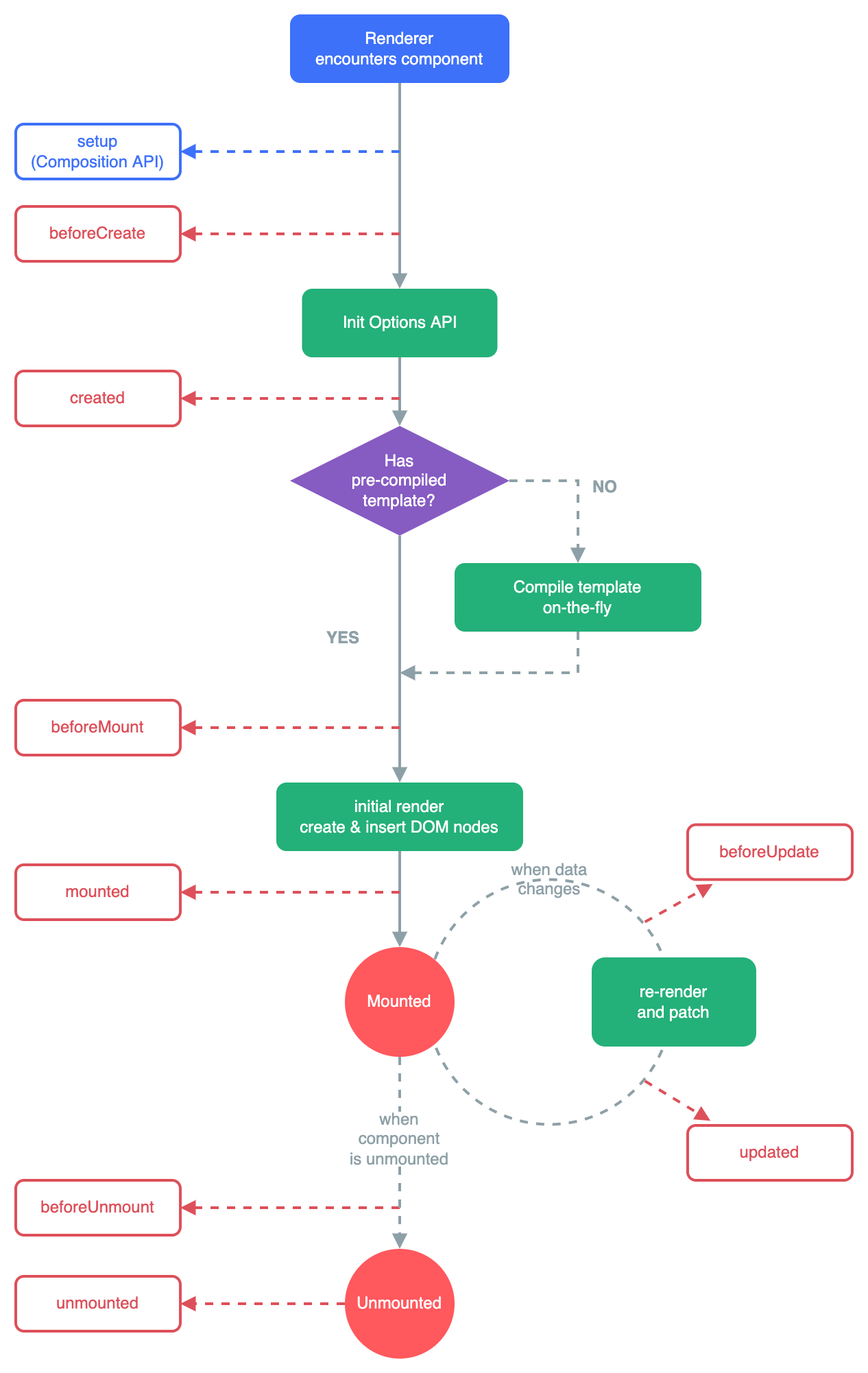常用地址及工具:
[vue3官网] https://cn.vuejs.org/ vue3官网
[setup 基本使用] https://juejin.cn/post/7002490039066165279 setup基本使用
[vite中文官网] https://cn.vitejs.dev/ Vite官网
1、如何使用vue3 + vite
//要构建一个 Vite + Vue 项目,运行,使用 NPM:
npm init @vitejs/app 项目名
//使用 Yarn:
yarn create @vitejs/app 项目名
// 启动项目
cd app
// 你会觉得非常快速的创建了项目,然而它并没有给你下载依赖,你还有进入文件然后
npm install (or yarn)
npm run dev (or yarn dev)
import { createApp } from 'vue'
import App from './App.vue'
createApp(App)mount('#app');
<!--
引入的不是vue构造函数,而是createApp工厂函数然而,创建实例对象其实就相当于vue2中的vm,mount('#app')就相当于$mount('#app'),并且vue2的写法在vue3不能兼容,
现在我们进入App组件,你会发现什么不一样的地方,他没有了根标签,在vue2的时候,我们都是在div根标签里面写东西,所以在vue3里面可以没有根标签
-->
<!-- vue2写法 -->
<template>
<div class='container'>
</div>
</template>
<!-- vue3写法 -->
<template>
<div class='container-left'></div>
<div class='container-right'></div>
</template>
2、常用组合式API
①【setup函数是 Composition API(组合API)的入口】,在setup函数中定义的变量和方法最后都是需要 return 出去的 不然无法再模板中使用。
<script>
export default {
name: 'App',
setup(){
let name = '王大锤'
let hello = 'hello!'
//方法
function sayHello(){
console.log(`我叫${name},say${age}`)
}
//返回一个对象
return {
name,
age,
say
}
}
}
</script>
当然这不是响应式的写法,然后你们可能会问,为什么没有用this,我们要想一想之前为什么要用this,还不是作用域的问题,然而这次我们都在setup里面,所以不会用到this,而且这里兼容vue2的写法如:data,methods…,并且在vue2中可以读取到vue3里的配置但是vue3里面不能读取到vue2的配置,所以,vue3和vue2不要混用,如果有重名那么优先setup。
ps.如果大家不喜欢return这样的写法的话,可以用vue3新语法糖
父组件
<template>
<div class="home">
<HelloWorld wish="不掉发" wishes="变瘦" @carried="carried">
<h3>实现插槽1</h3>
<template v-slot:dome>
<h4>实现插槽2</h4>
</template>
</HelloWorld>
</div>
</template>
<script>
import HelloWorld from "./components/HelloWorld";
export default {
name: 'Home',
components:{
HelloWorld
},
setup(){
function carried(value){
alert(`牛呀,都实现了!!!${value}`)
}
return {
carried
}
}
}
</script>
-------
子组件
<template>
<h1>HelloWorld</h1>
<h1>{{ wish }}</h1>
<button @click="dream">点击实现</button>
<slot></slot>
<slot name="dome"></slot>
</template>
<script>
export default {
name: "HelloWorld",
props: ["wish",'wishes'],
emits:['carried'],
setup(props,context) {
console.log(props)
console.log(context.attrs)
function dream(){
context.emit('carried',666)
}
return{
dream
}
},
};
</script>
<style scoped></style>
④ ref 和 reactive
- ref用来定义:基本类型数据。
- ref通过Object.defineProperty()的get与set来实现响应式(数据劫持)。
- ref定义的数据:操作数据需要.value,读取数据时模板中直接读取不需要.value。
- reactive用来定义:对象或数组类型数据。
- reactive通过使用Proxy来实现响应式(数据劫持), 并通过Reflect操作源代码内部的数据。
- reactive定义的数据:操作数据与读取数据:均不需要.value。 当然,我之前就说过,ref可以定义对象或数组的,它只是内部自动调用了reactive来转换。
3、vue3响应式原理
说到vue3的响应式原理,那我们就不得不提一句vue2的响应式了,(狗都知道的一句)通过Object.defineProperty的get,set来进行数据劫持,修改,从而响应式,但是它有什么缺点呢😶
- 由于只有get()、set() 方式,所以只能捕获到属性读取和修改操作,当 新增、删除属性时,捕获不到,导致界面也不会更新。
- 直接通过下标修改数组,界面也不会自动更新。 ok,vue2就聊这么多,什么?你还想听vue2底层?那你就Alt+←,拜拜了您嘞。
对于vue3中的响应式,我们用到的Proxy,当然,我们在vue2里面知道,Proxy是什么,是代理,当然,并不是只用到了它,还有个Window上的内置对象Reflect(反射)
- 通过Proxy(代理): 拦截对象中任意属性的变化, 包括:属性值的读写、属性的添加、属性的删除等。
- 通过Reflect(反射): 对源对象的属性进行操作。
const p=new Proxy(data, {
// 读取属性时调用
get (target, propName) {
return Reflect.get(target, propName)
},
//修改属性或添加属性时调用
set (target, propName, value) {
return Reflect.set(target, propName, value)
},
//删除属性时调用
deleteProperty (target, propName) {
return Reflect.deleteProperty(target, propName)
}
})
4、 computed
在vue3中,把computed变成为组合式API,那么就意味着你要去引入它,代码如下:
<template>
<div class="home">
姓:<input type="text" v-model="names.familyName"><br>
名:<input type="text" v-model="names.lastName"><br>
姓名:{{fullName}}<br>
</div>
</template>
<script>
import {reactive,computed} from 'vue'
export default {
name: 'Home',
setup(){
let names=reactive({
familyName:'阿',
lastName:'斌'
})
fullName=computed(()=>{
return names.familyName+'.'+names.lastName
})
return {
names,
fullName
}
}
}
</script>
要是你去修改计算出来的东西,你知道会发生什么吗?警告的意思是计算出来的东西是一个只读属性。
那要是我们想要修改怎么办呢,那么就要用到computed的终结写法了
<template>
<div class="home">
姓:<input type="text" v-model="names.familyName"><br>
名:<input type="text" v-model="names.lastName"><br>
姓名:<input type="text" v-model="names.fullName"><br>
</div>
</template>
<script>
import {reactive,computed} from 'vue'
export default {
name: 'Home',
setup(){
let names=reactive({
familyName:'阿',
lastName:'斌'
})
names.fullName=computed({
get(){
return names.familyName+'.'+names.lastName
},
set(value){
let nameList=value.split('.')
names.familyName=nameList[0]
names.lastName=nameList[1]
}
})
return {
names
}
}
}
</script>
5、watch
<template>
<div class="home">
<h1>当前数字为:{{num}}</h1>
<button @click="num++">点击数字加一</button>
</div>
</template>
<script>
import {ref,watch} from 'vue'
export default {
name: 'Home',
setup(){
let num=ref('0')
watch(num,(newValue,oldValue)=>{
console.log(`当前数字增加了,${newValue},${oldValue}`)
})
return {
num
}
}
}
</script>
当然这是监听ref定义出来的单个响应式数据,要是监听多个数据应该怎么办呢?其实可以用多个watch去进行监听,当然这不是最好的方法,最好的办法其实是监视数组
watch([num,msg],(newValue,oldValue)=>{
console.log('当前改变了',newValue,oldValue)
})
既然我们监听的是数组,那么我们得到的newValue和oldValue也就是数组,那么数组中的第一个就是你监视的第一个参数。
ps.当然之前在vue2中watch不是有什么其他参数吗,vue3中也有,是写在最后的。
watch([num,msg],(newValue,oldValue)=>{
console.log('当前改变了',newValue,oldValue)
},{immediate:true,deep:true})
之前我说过,我们现在监听的是监听ref定义出来数据,那么要是我们监听的是reactive
<template>
<div class="home">
<h1>当前姓名:{{names.familyName}}</h1>
<h1>当前年龄:{{names.age}}</h1>
<h1>当前薪水:{{names.job.salary}}K</h1>
<button @click="names.familyName+='!'">点击加!</button>
<button @click="names.age++">点击加一</button>
<button @click="names.job.salary++">点击薪水加一</button>
</div>
</template>
<script>
import {reactive,watch} from 'vue'
export default {
name: 'Home',
setup(){
let names=reactive({
familyName: '鳌',
age:23,
job:{
salary:10
}
})
watch(names,(newValue,oldValue)=>{
console.log(`names改变了`,newValue,oldValue)
},{deep:false})
return {
names
}
}
}
</script>
但是你会发现一个问题,为什么newValue与oldValue一样呢,就很尴尬,都是新的数据,就算你使用ref来定义,还是没有办法监听到oldValue(他喵的,都给你说了ref定义的对象会自动调用reactive),所以在监视reactive定义的响应式数据时,oldValue无法正确获取,并且你会发现,它是**强制开启深度监视(deep:true),并且无法关闭。
然而现在我们监视的是reactive定义的响应式数据的全部属性,是只监听其中的一个属性,那怎么办呢,可能大家会
watch(names.age,(newValue,oldValue)=>{
console.log(`names改变了`,newValue,oldValue)
})
来进行监视,但是,vue3会警告只能监听reactive定义的或者ref定义的,并且不能监听。
那么我们就必须这样写(不会还有人不知道return可以省略吧?不会吧?不会吧?不会那个人就是你吧?)
// 监听单个属性
watch(()=>names.age,(newValue,oldValue)=>{
console.log('names改变了',newValue,oldValue)
})
// 监听多个属性
watch([()=>names.age,()=>names.familyName],(newValue,oldValue)=>{
console.log('names改变了',newValue,oldValue)
})
ok,要是我们监听的是深度的属性那要怎么办呢?你会发现我要是只监听第一层是监听不到的,那么我们有两种写法
//第一种
watch(()=> names.job.salary,(newValue,oldValue)=>{
console.log('names改变了',newValue,oldValue)
})
//第二种
watch(()=> names.job,(newValue,oldValue)=>{
console.log('names改变了',newValue,oldValue)
},{deep:true})
6、watchEffect
watchEffect是vue3的新函数,它是来和watch来抢饭碗的,它和watch是一样的功能,那它有什么优势呢?
- 自动默认开启了immediate:true
- 用到了谁就监视谁
watchEffect(()=>{
const one = num.value
const tow = person.age
console.log('watchEffect执行了')
})
其实吧,watchEffect有点像computed,都是里面的值发生了改变就调用一次,但是呢computed要写返回值,而watchEffect不用写返回值。
7、生命周期
我们先来简单分析下,在vue2中,我们是先new Vue(),然后执行beforeCreate与created接着问你有没有vm.$mount(el),有,才继续执行,但是在vue3中,它是先全部准备好后然后再进行函数。
其实在vue3中生命周期没有多大的改变,只是改变了改变了销毁前,和销毁,让它更加语义化了 beforeDestroy改名为beforeUnmount,destroyed改名为unmounted
然后在vue3中,beforeCreate与created并没有组合式API中,setup就相当于这两个生命周期函数
在vue3中也可以按照之前的生命周期函数那样写,只是要记得有些函数名称发生了改变
在setup里面应该这样写
- beforeCreate===>Not needed*
- created=======>Not needed*
- beforeMount ===>onBeforeMount
- mounted=======>onMounted
- beforeUpdate===>onBeforeUpdate
- updated =======>onUpdated
- beforeUnmount ==>onBeforeUnmount
- unmounted =====>onUnmounted
8、hooks 函数
- Vue3 的 hook函数 相当于 vue2 的 mixin, 不同在与 hooks 是函数
- Vue3 的 hook函数 可以帮助我们提高代码的复用性, 让我们能在不同的组件中都利用 hooks 函数
其实就是代码的复用,可以用到外部的数据,生命钩子函数…,具体怎么用直接看代码,
/一般都是建一个hooks文件夹,都写在里面
import {reactive,onMounted,onBeforeUnmount} from 'vue'
export default function (){
//鼠标点击坐标
let point = reactive({
x:0,
y:0
})
//实现鼠标点击获取坐标的方法
function savePoint(event){
point.x = event.pageX
point.y = event.pageY
console.log(event.pageX,event.pageY)
}
//实现鼠标点击获取坐标的方法的生命周期钩子
onMounted(()=>{
window.addEventListener('click',savePoint)
})
onBeforeUnmount(()=>{
window.removeEventListener('click',savePoint)
})
return point
}
//在其他地方调用
import useMousePosition from './hooks/useMousePosition'
let point = useMousePosition()
9、toRef 与 toRefs
toRef
toRef翻译过来其实就是把什么变成ref类型的数据,可能大家会觉得没有什么用,毕竟我们之前定义时就已经定义成ref,但是你们想一想,我们在之前是怎么写的
<template>
<div class="home">
<h1>当前姓名:{{names.name}}</h1>
<h1>当前年龄:{{names.age}}</h1>
<h1>当前薪水:{{names.job.salary}}K</h1>
<button @click="names.name+='!'">点击加!</button>
<button @click="names.age++">点击加一</button>
<button @click="names.job.salary++">点击薪水加一</button>
</div>
</template>
<script>
import {reactive} from 'vue'
export default {
name: 'Home',
setup(){
let names=reactive({
name:'老谭',
age:23,
job:{
salary:10
}
})
return {
names
}
}
}
</script>
是不是一直都是用到代码name.xx,可能你会说,那我就return的时候不这样写,改成这样
return {
name:names.name,
age:names.age,
salary:names.job.salary
}
但是你要是在页面进行操作时就不是响应式了,为什么呢?那是因为你现在暴露出去的是简简单单的字符串,字符串会有响应式吗?肯定没有呀,但是你要是用到了toRef,那就是把name.xx变为响应式,然后操作它时会自动的去修改name里面的数据
return {
name:toRef(names,'name'),
age:toRef(names,'age'),
salary:toRef(names.job,'salary')
}
但是有的人可能会说那我为什么不用ref去改变?可能大家会发现在页面里也是响应式的,但是我告诉你们,根本用到的不是names里面的数据,而是你单独定义出来的数据,所以要是这样写,无论怎么修改都不会修改到names里的数据
return {
name:ref(names.name),
age:ref(names.age),
salary:ref(names.job.salary),
}
toRefs
聪明一点,toRefs与toRef有什么不同,加了个s,toRef是单个转化为响应式,那toRefs就是多个转化为响应式咯,这样的话就减少代码,不然要是有成千上万个,那你不是要当憨憨闷写吗?(…是结构哈,看不懂就麻溜的alt+←),当然它只会结构一层,深层里的代码还是要老实的写
<h1>当前姓名:{{name}}</h1>
<h1>当前薪水:{{job.salary}}K</h1>
return {
...toRefs(names)
}
10、toRaw 与 markRaw
toRaw其实就是将一个由reactive生成的响应式对象转为普通对象。如果是ref定义的话,是没有效果的(包括ref定义的对象)如果在后续操作中对数据进行了添加的话,添加的数据为响应式数据,当然要是将数据进行markRaw操作后就不会变为响应式,可能大家会说,不就是和readonly一样吗?那肯定不一样咯,readonly是根本没办法改,但markRaw是不转化为响应式,但是数据还会发生改变。
<template>
<div class="home">
<h1>当前姓名:{{names.name}}</h1>
<h1>当前年龄:{{names.age}}</h1>
<h1>当前薪水:{{names.job.salary}}K</h1>
<h1 v-if="names.girlFriend">女朋友:{{names.girlFriend}}</h1>
<button @click="names.name+='!'">点击加!</button>
<button @click="addAges">点击加一</button>
<button @click="addSalary">点击薪水加一</button>
<button @click="add">添加女朋友</button>
<button @click="addAge">添加女朋友年龄</button>
</div>
</template>
<script>
import {reactive,toRaw,markRaw} from 'vue'
export default {
name: 'Home',
setup(){
let names=reactive({
name:'老伍',
age:23,
job:{
salary:10
}
})
function addAges(){
names.age++
console.log(names)
}
function addSalary(){
let fullName=toRaw(names)
fullName.job.salary++
console.log(fullName)
}
function add(){
let girlFriend={sex:'女',age:40}
names.girlFriend=markRaw(girlFriend)
}
function addAge(){
names.girlFriend.age++
console.log(names.girlFriend.age)
}
return {
names,
add,
addAge,
addAges,
addSalary
}
}
}
</script>
11、customRef
customRef创建一个自定义的 ref,并对其依赖项跟踪和更新触发进行显式控制。
单纯觉得这个东西的作用只有防抖的作用
<template>
<input type="text" v-model="keyWord">
<h3>{{keyWord}}</h3>
</template>
<script>
import {customRef} from 'vue'
export default {
name: 'App',
setup() {
//自定义一个ref——名为:myRef
function myRef(value,times){
let time
return customRef((track,trigger)=>{
return {
get(){
console.log(`有人从myRef中读取数据了,我把${value}给他了`)
track() //通知Vue追踪value的变化(必须要有,并且必须要在return之前)
return value
},
set(newValue){
console.log(`有人把myRef中数据改为了:${newValue}`)
clearTimeout(time)
time = setTimeout(()=>{
value = newValue
trigger() //通知Vue去重新解析模板(必须要有)
},times)
},
}
})
}
let keyWord = myRef('HelloWorld',1000) //使用自定义的ref
return {keyWord}
}
}
</script>
防抖:在第一次触发事件时,不立即执行函数,而是给出一个时间段,如果短时间内大量触发同一事件,只会执行一次函数。
节流:函数执行一次后,在某个时间段内暂时失效,过了这段时间后再重新激活,如果短时间内大量触发同一事件,那么在函数执行一次之后,该函数在指定的时间期限内不再生效,直至过了这段时间才重新生效。(可以理解为游戏技能冷却期)
12、provide 与 inject
都知道组件传值吧,在vue2中,如果要在后代组件中使用父组件的数据,那么要一层一层的父子组件传值或者用到vuex,但是现在,无论组件层次结构有多深,父组件都可以作为其所有子组件的依赖提供者。这个特性有两个部分:父组件有一个 provide 选项来提供数据,子组件有一个 inject 选项来开始使用这些数据。
//父
import { provide } from 'vue'
setup(){
let fullname = reactive({name:'阿月',salary:'15k'})
provide('fullname',fullname) //给自己的后代组件传递数据
return {...toRefs(fullname)}
}
//后代
import {inject} from 'vue'
setup(){
let fullname = inject('fullname')
return {fullname}
}
13、响应式判断
- isRef: 检查值是否为一个 ref 对象。
- isReactive:检查对象是否是由 reactive 创建的响应式代理。
- isReadonly: 检查对象是否是由 readonly 创建的只读代理。
- isProxy:检查对象是否是由 reactive 或 readonly 创建的 proxy。
import {ref, reactive,readonly,isRef,isReactive,isReadonly,isProxy } from 'vue'
export default {
name:'App',
setup(){
let fullName = reactive({name:'小唐',price:'20k'})
let num = ref(0)
let fullNames = readonly(fullName)
console.log(isRef(num))
console.log(isReactive(fullName))
console.log(isReadonly(fullNames))
console.log(isProxy(fullName))
console.log(isProxy(fullNames))
console.log(isProxy(num))
return {}
}
}
14、Fragment
对我而言这个更像是一种概念,它的意思就相当于创建页面时,给了一个虚拟根标签VNode,因为我们知道在vue2里面,我们是有根标签这个概念的,但是到来vue3,它是自动给你创建个虚拟根标签VNode(Fragment),所以可以不要根标签。好处就是 减少标签层级, 减小内存占用
15、Teleport
teleport 提供了一种有趣的方法,允许我们控制在 DOM 中哪个父节点下渲染了 HTML,而不必求助于全局状态或将其拆分为两个组件。
其实就是可以不考虑你写在什么位置,你可以定义teleport在任意标签里进行定位等(常见操作为模态框),除了body外,还可以写css选择器(id,class)
//id定位
<teleport to="#app">
<div class="four">
<div class="five"></div>
</div>
</teleport>
//class定位
<teleport to=".one">
<div class="four">
<div class="five"></div>
</div>
</teleport>
//示例
<template>
<div class="one">
<h1>第一层</h1>
<div class="two">
<h1>第二层</h1>
<div class="three">
<h1>第三层</h1>
<teleport to="body">
<div class="four">
<div class="five"></div>
</div>
</teleport>
</div>
</div>
</div>
</template>
<script>
export default {
name:'App',
setup(){
return {}
}
}
</script>
<style lang="less">
.one{
width: 100%;
background-color: blue;
.two{
margin: 20px;
background-color: aqua;
.three{
margin: 20px;
background-color: aliceblue;
}
}
}
.four{
position: absolute;
top: 0;
bottom: 0;
left: 0;
right: 0;
background-color: rgba(0, 0, 0, 0.5);
.five{
position: absolute;
top: 50%;
left: 50%;
transform: translate(-50%,-50%);
width: 300px;
height: 300px;
left: 50%;
background-color:#f60;
}
}
</style>
16、全局API的转移
| 2.x 全局 API(Vue) | 3.x 实例 API (app) |
|---|---|
| Vue.config.xxxx | app.config.xxxx |
| Vue.config.productionTip | 移除 |
| Vue.component | app.component |
| Vue.directive | app.directive |
| Vue.mixin | app.mixin |
| Vue.use | app.use |
| Vue.prototype | app.config.globalProperties |
其他改变:
移除keyCode作为 v-on 的修饰符,同时也不再支持config.keyCodes
移除v-on.native修饰符
移除过滤器(filter)
…




